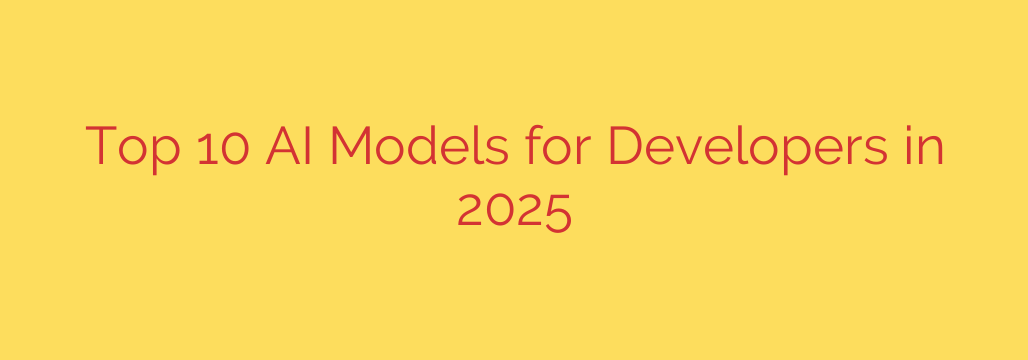
The Top AI Models Every Developer Should Know in 2025
The landscape of software development is undergoing a seismic shift, driven by the rapid evolution of artificial intelligence. What was once a niche tool for data scientists has become an indispensable part of the modern developer’s toolkit. From generating boilerplate code to debugging complex algorithms and creating stunning visual assets, AI models are accelerating workflows and unlocking new creative possibilities.
As we look toward 2025, staying current with the most impactful models isn’t just an advantage—it’s a necessity. This guide breaks down the essential AI models and platforms that developers should have on their radar, categorized by their primary use cases.
Foundational Large Language Models (LLMs)
These general-purpose models are the powerhouses behind many AI-driven applications. They excel at understanding and generating human-like text, making them incredibly versatile for coding, documentation, and complex problem-solving.
GPT-4 and its Successors (OpenAI): Still the reigning champion in many respects, the GPT series sets the benchmark for logical reasoning, language nuance, and code generation. For developers, its primary strength lies in its unmatched versatility. You can use it to draft emails, write technical documentation, refactor complex code snippets, or even brainstorm architectural patterns. Its ability to handle abstract and complex problems makes it an invaluable digital assistant.
Claude 3 (Anthropic): Claude has emerged as a formidable competitor, distinguished by its enormous context window. This allows it to process and analyze vast amounts of information at once—think entire codebases, lengthy technical manuals, or extensive project documentation. For developers, this means you can ask questions about your whole project, not just isolated files. It also has a strong reputation for its focus on safety and producing reliable, less “hallucinatory” output.
Gemini (Google): Google’s flagship model is built from the ground up to be multimodal. While other models have multimodality bolted on, Gemini’s core strength is its ability to seamlessly reason across text, images, code, and audio. For developers, this translates to powerful new applications, such as generating code from a UI sketch or debugging based on a screenshot of an error message. Its deep integration with the Google Cloud ecosystem also makes it a natural choice for teams already invested in that platform.
Llama 3 (Meta): As the leading open-source model, Llama 3 is a game-changer for developers who need more control, privacy, and customization. Because it can be self-hosted, you can run it on your own hardware, ensuring your proprietary code never leaves your network. This also opens the door to unparalleled customization through fine-tuning, allowing you to create a version of the model that is highly specialized for your company’s unique codebase or industry jargon.
Specialized Code Generation and Assistance
While general LLMs are great, specialized tools integrated directly into the development environment offer the most seamless experience for day-to-day coding.
- GitHub Copilot: More of an application than a raw model, GitHub Copilot is arguably the most impactful AI tool for developers today. Powered by OpenAI’s models, it functions as an AI pair programmer directly within your IDE (like VS Code). Its strength is its context-aware code completion, suggesting entire lines or even functions based on your existing code and comments. It dramatically reduces time spent on boilerplate and helps you learn new libraries and frameworks on the fly.
AI Models for Image and Asset Creation
Modern development isn’t just about code; it’s also about creating compelling user interfaces, marketing materials, and in-game assets. AI image generation models have become essential for this.
Stable Diffusion 3: This is the go-to open-source model for image generation. Its key advantage is fine-grained control and flexibility. Developers and designers can run it locally, use thousands of community-trained custom models, and fine-tune it on their own art styles. It’s perfect for generating specific assets like UI icons, website hero images, or game textures with a consistent look and feel.
Midjourney: While it operates primarily through a Discord interface, Midjourney remains the king of high-quality, artistic, and hyper-realistic visuals. For teams that need top-tier concept art, marketing images, or inspirational mood boards, Midjourney produces results that are often indistinguishable from human-created art. It’s less for automated asset pipelines and more for creating stunning, polished final images.
Actionable Advice: How to Choose the Right AI Model
With so many options, selecting the right tool can be daunting. Here are four key factors to consider:
Define Your Primary Use Case: Are you looking for a coding assistant, a documentation writer, or an asset generator? A specialized tool like GitHub Copilot is best for in-IDE coding, while a powerful LLM like Claude is better for analyzing a whole repository.
Consider Open Source vs. Commercial APIs: If data privacy and customization are your top priorities, a self-hosted open-source model like Llama 3 is the best choice. If you prioritize ease of use and cutting-edge performance without the overhead of managing infrastructure, commercial APIs from OpenAI or Google are more practical.
Evaluate Performance and Cost: The most powerful models are often the most expensive to run via API. Test different models for your specific tasks. Sometimes a smaller, faster model is more than capable and will save you significant costs in the long run.
Prioritize Security: Never paste sensitive, proprietary, or secret code into a public web interface or a third-party API without fully understanding its data usage policies. For confidential projects, always lean toward self-hosted open-source models or enterprise-grade versions of commercial tools that guarantee data privacy.
The era of AI-augmented development is here. By understanding the strengths of these key models, developers can not only enhance their productivity but also push the boundaries of what they can build.
Source: https://collabnix.com/the-top-10-ai-models-every-developer-should-know-in-2025-a-comprehensive-guide/








